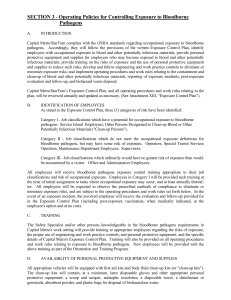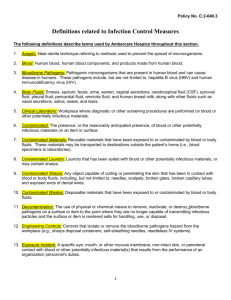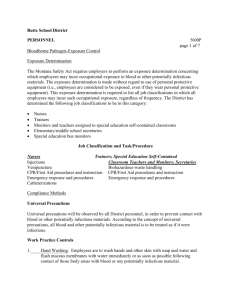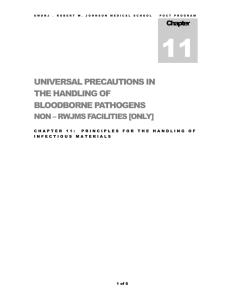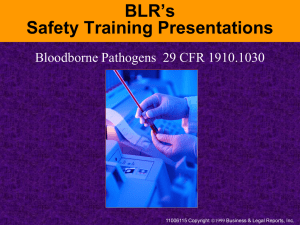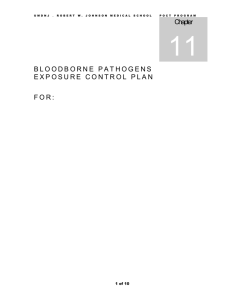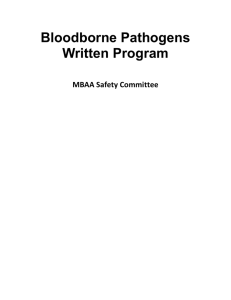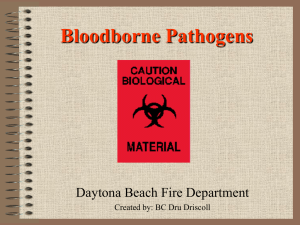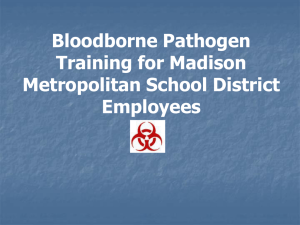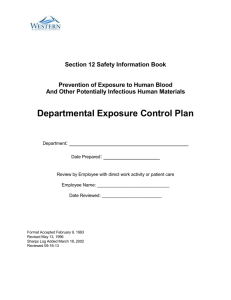gbgaa-r - Cherryfield Elementary School
advertisement
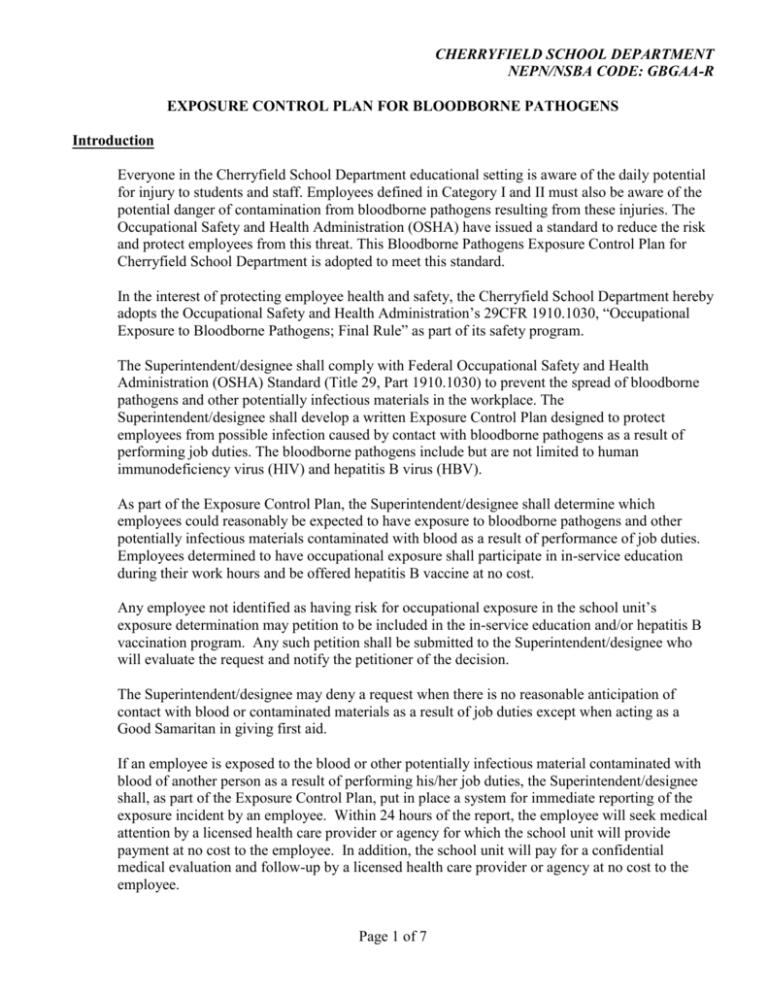
CHERRYFIELD SCHOOL DEPARTMENT NEPN/NSBA CODE: GBGAA-R EXPOSURE CONTROL PLAN FOR BLOODBORNE PATHOGENS Introduction Everyone in the Cherryfield School Department educational setting is aware of the daily potential for injury to students and staff. Employees defined in Category I and II must also be aware of the potential danger of contamination from bloodborne pathogens resulting from these injuries. The Occupational Safety and Health Administration (OSHA) have issued a standard to reduce the risk and protect employees from this threat. This Bloodborne Pathogens Exposure Control Plan for Cherryfield School Department is adopted to meet this standard. In the interest of protecting employee health and safety, the Cherryfield School Department hereby adopts the Occupational Safety and Health Administration’s 29CFR 1910.1030, “Occupational Exposure to Bloodborne Pathogens; Final Rule” as part of its safety program. The Superintendent/designee shall comply with Federal Occupational Safety and Health Administration (OSHA) Standard (Title 29, Part 1910.1030) to prevent the spread of bloodborne pathogens and other potentially infectious materials in the workplace. The Superintendent/designee shall develop a written Exposure Control Plan designed to protect employees from possible infection caused by contact with bloodborne pathogens as a result of performing job duties. The bloodborne pathogens include but are not limited to human immunodeficiency virus (HIV) and hepatitis B virus (HBV). As part of the Exposure Control Plan, the Superintendent/designee shall determine which employees could reasonably be expected to have exposure to bloodborne pathogens and other potentially infectious materials contaminated with blood as a result of performance of job duties. Employees determined to have occupational exposure shall participate in in-service education during their work hours and be offered hepatitis B vaccine at no cost. Any employee not identified as having risk for occupational exposure in the school unit’s exposure determination may petition to be included in the in-service education and/or hepatitis B vaccination program. Any such petition shall be submitted to the Superintendent/designee who will evaluate the request and notify the petitioner of the decision. The Superintendent/designee may deny a request when there is no reasonable anticipation of contact with blood or contaminated materials as a result of job duties except when acting as a Good Samaritan in giving first aid. If an employee is exposed to the blood or other potentially infectious material contaminated with blood of another person as a result of performing his/her job duties, the Superintendent/designee shall, as part of the Exposure Control Plan, put in place a system for immediate reporting of the exposure incident by an employee. Within 24 hours of the report, the employee will seek medical attention by a licensed health care provider or agency for which the school unit will provide payment at no cost to the employee. In addition, the school unit will pay for a confidential medical evaluation and follow-up by a licensed health care provider or agency at no cost to the employee. Page 1 of 7 CHERRYFIELD SCHOOL DEPARTMENT NEPN/NSBA CODE: GBGAA-R Medical records will be maintained by the school unit for thirty years after the employment of those employees who report exposure to bloodborne pathogens as a result of performance of job duties. Further, the medical records will be stored in compliance with federal, state and local laws regarding privacy and confidentiality of all medical records and any additional legal protection for information related to HIV infection and AIDS. Records of participation in in- service programs provided by the school unit for employees will be compiled and maintained for three years. Purpose The Purpose of the Exposure Control Plan is to provide and maintain a safe working environment for all employees by eliminating and/or minimizing occupational exposure to bloodborne pathogens, including but not limited to Hepatitis B Virus (HBV), and Human Immunodeficiency Virus (HIV). It is the responsibility of the employer to provide and maintain appropriate engineering controls and personal protective equipment, and to develop, establish, and promote safe work practices, ongoing training and education for its employees. It is also expected that employees will practice and follow the guidelines set forth by this plan. Scope This plan covers all employees who could be “reasonable anticipated”, as a result of the performance of their job duties, to come into contact with blood or other potentially infectious materials. See Category I and II (see pages 3 and 4). “Good Samaritan” acts, such as assisting a co-worker with a nosebleed, would not be considered an occupational exposure. Background The Center for Disease Control (CDC) has recognized the following as linked to the potential transmission of HBV, HIV, and other bloodborne Pathogens in the occupations setting: blood/blood products or components semen vaginal secretions amniotic fluid saliva (in dentistry) any body fluid visibly contaminated with blood pleural fluid peritoneal fluid cerebrospinal fluid all body fluids in situations where it may be difficult of impossible to differentiate between body fluids These substances shall be collectively referred to as blood or “other potentially infectious material” (OPIM) for the remainder of this document. Page 2 of 7 CHERRYFIELD SCHOOL DEPARTMENT NEPN/NSBA CODE: GBGAA-R Exposure Control Plan In accordance with the Occupational Safety and Health Administration (OSHA) regulations dealing with “Safe Workplace” standards (29 CFR 1910.1030) relating to exposure to Bloodborne Pathogens, the following plan and procedures have been developed for Cherryfield School Department employees. It will be the plan of the Cherryfield School Department to take all reasonable necessary actions to protect its employees from infectious disease and in particular HIV and HBV infection. The Cherryfield School Department will provide training and protective equipment to those persons who are at risk by virtue of their job performance and may come in contact with infectious disease. This plan shall be reviewed annually by the school administration. Exposure Determination OSHA requires employers to perform an exposure determination identifying which employees may incur occupations exposure to blood or other potentially infectious materials. The exposure determination is made without regard to the use of personal protective equipment (i.e., employees are considered to be exposed even if they wear personal protective equipment). This exposure determination is required to list all job categories in which all employees may be expected to incur such occupational exposure, regardless of frequency. The following job categories exist within this school unit: a. Identified job categories for Cherryfield faculty, staff and administration where occupational exposure to blood occurs without regard to personal protective clothing or equipment. Category I: Employees who are likely to have occupational exposure as part of their normal work routine are: Nurses Custodians Secretaries Principal Bus Drivers Coaches Cooks Physical Education Teachers Special Education Teachers and Educational Technicians a. Identified tasks associated with the above categories. Task defined: Any activity which involves the handling of or possibility of handling of blood or other potentially infectious materials as described above. Page 3 of 7 CHERRYFIELD SCHOOL DEPARTMENT NEPN/NSBA CODE: GBGAA-R Administering First Aid Care of the sick Decontamination of the environment Category II: Employees who may have occupational exposure, but not as a part of their normal work routine are: All other Cherryfield School Department employees Employee Awareness This plan will be accessible to Cherryfield School Department employees through the following means: a. Copies of the plan are to be in the school facility where employees have access to them. b. Copies of the plan will be sent to all administrative personnel for insertion into the policy book. c. Training of employees will be done on a yearly basis for all employees in Category I. Annual Review and Update: At the end of each school year, the policy/plan is to be analyzed and updated. The review will be conducted by Cherryfield School Department health personnel, a representative from personnel, the Superintendent or designee and a representative of the Safety Committee. The updated plan will be distributed to those indicated in the previous section. Implementation Schedule and Methodology: State of Maine Department of Labor requires that this plan also include a schedule and method of implementation for the various requirements of the standard. The following complies with this requirement. A. Compliance Methods Universal precautions will be observed in this school unit to prevent contact with blood or other potentially infectious materials. “Universal Precautions” is an approach of infection control. The concept of universal precautions is that all human blood and body fluids are treated as if known to contain disease-causing germs (pathogens). It is not always possible to know when blood or body fluids are infectious; therefore, all body fluids shall be handled as if infectious. All employees shall routinely observe the following universal precautions to prevent and reduce spread of infectious disease. B. Personal Protective Equipment Page 4 of 7 CHERRYFIELD SCHOOL DEPARTMENT NEPN/NSBA CODE: GBGAA-R All personal protective equipment used in the school unit will be provided without cost to employees. Personal protective equipment will be considered appropriate only if it does not permit blood and other potentially infectious materials to pass through or reach the employee’s clothing, skin, eyes, mouth or other mucous membranes. Gloves shall be worn where it is reasonably anticipated that employees will have hand contact with blood, other potentially infectious material, non-intact skin, and mucous membranes. Gloves will be used for the following procedures: administering first aid, housekeeping tasks, nursing procedures (e.g., catheterization, suctioning, assisting an incontinent student, etc.). Gloves will be available from health/nurse’s offices and custodial areas. Wear disposable waterproof gloves whenever you expect to come into direct contact with blood, other body fluids containing blood, or contaminated items and surfaces. This applies to incidents including, but not limited to, caring for nose bleeds or cuts, cleaning up spills, or handling clothing soiled by blood or body fluids containing blood. Do not reuse gloves. After each use, remove gloves without touching the outside and dispose of them in a lined waste container. C. Engineering controls 1. Sharps containers—located in appropriate health/nurse’s offices. These containers will be examined and maintained on a regular schedule. When sharps containers are full, the school nurse will be responsible for making arrangements to having them transported to a licensed biomedical waste facility. School nurses will inspect sharps containers with each use. Contaminated needles and other contaminated sharps will not be bent, recapped, or removed. 2. Hand Washing facilities Hand Washing facilities are available to employees who incur exposure to blood or other potential infectious materials. OSHA requires that these facilities be readily accessible after incurring exposure. Within this school unit hand washing facilities are located in most bathrooms, in most custodial areas, in kitchen areas, in some classrooms, and in the health/nurse’s offices. After removal of personal protective gloves, employees shall wash hands and any other potentially contaminated skin area with soap and water immediately or as soon as feasible. All staff should routinely observe the following universal precautions to prevent and reduce spread of infectious disease: a. Wash your hands and any other contacted skin surfaces thoroughly for 15 to 30 seconds with dispensable soap and warm running water, rinse under running water and dry thoroughly with disposable paper towel. 1) Immediately after any accidental contact with blood, body fluids, or drainage from wounds with soiled garments, objects or surfaces; Page 5 of 7 CHERRYFIELD SCHOOL DEPARTMENT NEPN/NSBA CODE: GBGAA-R 2) Immediately after removing gloves or other protective equipment or clothing; 3) Before assisting others with eating and drinking as well as eating or drinking yourself; 4) Before handling food, cleaning utensils or kitchen equipment; and 5) Before and after diapering and assisting with toileting, as well as toileting yourself. When running water is not available, use antiseptic hand cleanser and clean towels or antiseptic towelettes and use soap and running water as soon as feasible. D. b. Clean surfaces and equipment contaminated with blood with soap and water and disinfect them promptly with a fresh germicide (ten parts water to one part bleach) or other disinfectant. While cleaning, wear disposable gloves and use disposable towels whenever possible. Rinse mops or other reusable items in the disinfectant and dry thoroughly. c. Properly dispose of contaminated material and label them as biohazards. 1) Place blood, body fluids, gloves, bloody dressings and other materials soaked with blood into appropriately labeled plastic bags or lined waste container. Sharp disposable objects shall be disposed of in leak-proof, puncture-proof containers. 2) Bag soiled towels and other laundry and send home. 3) Dispose of urine, vomit, or feces in the sewer system. d. Do not care for others’ injuries if you have any bleeding or oozing wounds or skin conditions yourself. e. Use a mouthpiece, resuscitation bag or other ventilation device when readily available when it is necessary to provide mouth-to- mouth resuscitation. f. Immediately report any incident of accidental exposure to blood or first-aid incident that involved direct contact with blood in accordance with school unit policies about accident reporting and exposure. Housekeeping/Decontamination of Environment The following school facilities will be cleaned after each body fluid spill incident: all bathrooms; all health/nurse’s offices; all administrative areas; all daily use sink areas; and all water fountains. Page 6 of 7 CHERRYFIELD SCHOOL DEPARTMENT NEPN/NSBA CODE: GBGAA-R Decontamination will be accomplished by utilizing the following materials: A bleach solution: (1 part bleach to 10 parts water) (1:10 mixed when needed and not allowed to stand longer than 24 hours) or Germicide. All contaminated work surfaces will be decontaminated after completion of procedures, immediately after any spill of blood or other potentially infectious materials, and at the end of the work shift. All equipment (e.g., mops, brushes, dust pans) used in cleaning up potentially contaminated materials will be decontaminated immediately. All mops, brushes, bins, pails, cans and similar receptacles shall be inspected regularly and by custodians on a daily basis. Plastic bags in waste receptacles located in health/nurse’s offices and all bathrooms will be changed daily. Any broken glassware which may be contaminated will not be picked up directly with the hands. The following procedures will be used: brush and dust pan will be used to assist picking up contaminated glass. Potentially contaminated glass will be placed in a puncture-proof biohazard container. Handle contaminated laundry in areas of use. Always use appropriate personal protective equipment when handling contaminated laundry. Before transporting, place contaminated laundry in leak proof plastic bag and send home. E. Hepatitis B Vaccine All employees who have been identified as having occupational exposure to blood or other potential infectious material (category I) will be offered the Hepatitis B vaccine at no cost to the employee, within 10 working days of their initial assignment. Employees must sign the Bloodborne Pathogen Mandatory Declaration Statement (GBGAA-E1) indicating their consent, declination, or provide previous proof of vaccination. Employees who initially decline the vaccine but who later wish to have it may have the vaccine provided at no cost. The vaccine will be offered yearly if refused. Employees who consent to the vaccine will be given the Hepatitis B instruction sheet (GBGAA-E2). It is the employee’s responsibility to complete the series, and notify the Personnel Department of vaccination dates. All vaccines will be provided under the supervision of a licensed physician. DATE ADOPTED: January 13, 2015 Page 7 of 7

